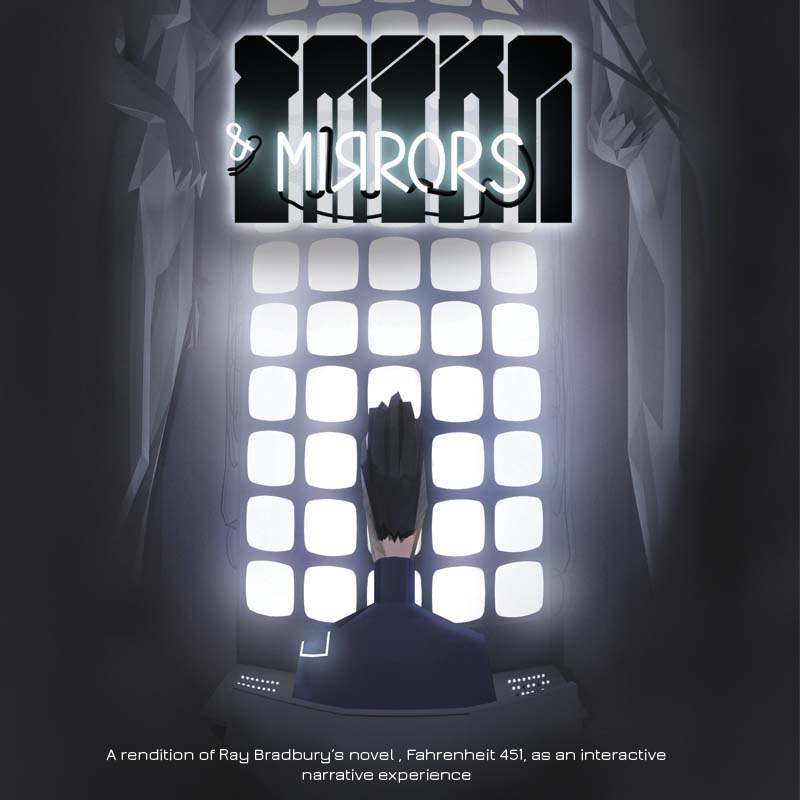

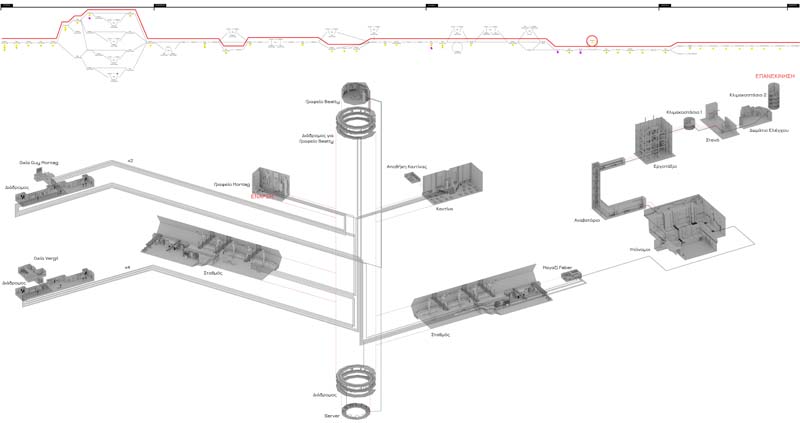

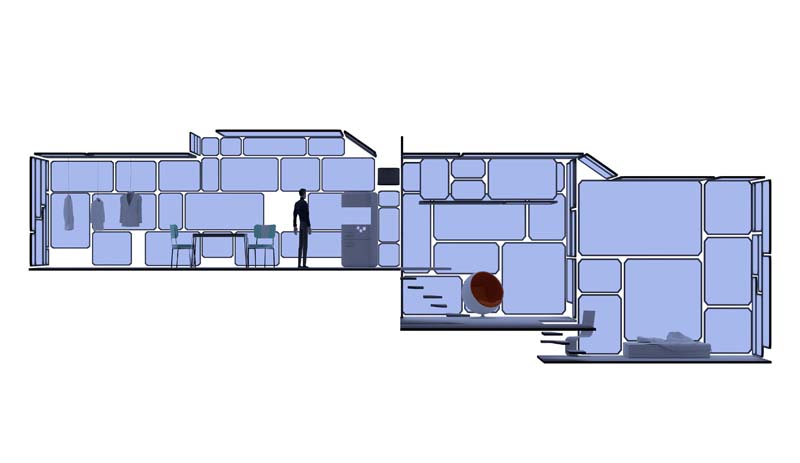



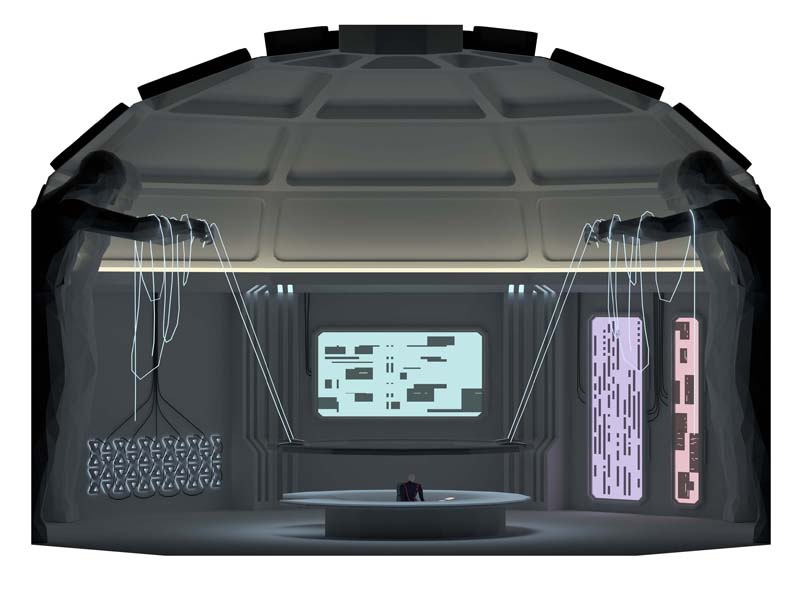

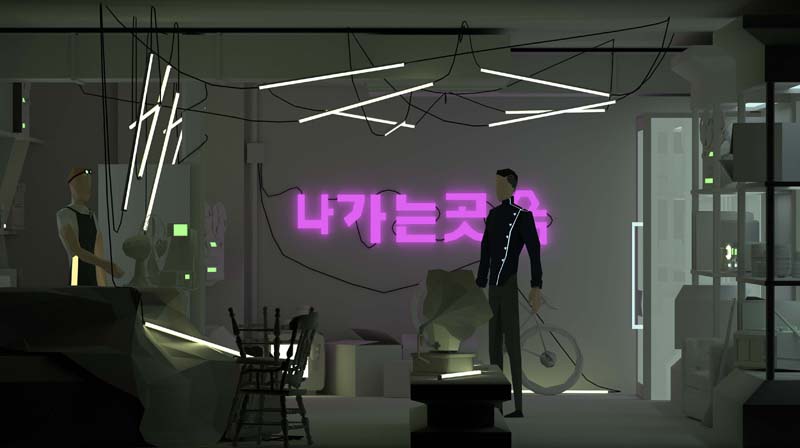

Smoke and Mirrors is a point and click narrative video game based on Ray Bradbury’s novel, Fahrenheit 451, enriched with elements from George Orwell’s novel, Nineteen Eighty Four. The timeline of the story it is an undefined future. Characters have no sense of current time, as they believe that the inception of their world coincides with rise of their government. It’s a seemingly utopic world where the habitants reside in happiness under the gazing eye of the government.
The narrative consists of the wondering of Montag, the main character, through a combination of individual and public spaces. Montag as a contemporary noir figure tries to find answers to his questions by engaging with the urban landscape and other characters in it. His personality transforms from a passive, law abiding fireman, to a vivid and anxious character. For ten years his only interest was to burn books until he found an old man, a writer, who talks about the past when people weren’t afraid and a professor who showed him a hopeful future.
Through the interactive narrative, the user can explore the world of Smoke and Mirrors at his one pace, choosing the order in which he visits the individual spaces of the game and undertakes the tasks. The unfolding of the story evolves in parallel with the progression of Montag’s character like a form of a theatrical show.
Supervisor: Papadopoulos Spiros
Reference Number: 656


The motive of the thesis was the desire of exploring the management of archaeological sites. After research, Velestino was chosen as the place of study, because of the existence of archaeological findings within the urban fabric. A fact that reinforced the willingness to further explore the ways in which the environment of a town, such as Velestino, can be associated with the remains of the history of the place. The findings of the above mention are the ancient Hyperian Fountain, located in Kefalovrysos, and the Mycenaean tombs, at a distance of about 70 meters from the northeast of the Hyperian Fountain. Having as initial intention to link the Hyperian Fountain square and the archaeological site of the Mycenaean tombs, the emphasis was placed on the individual design of the two points in order to highlight both the ancient and the environment, which are part of the public space.
The proposal concerns the redevelopment of the Hyperian Fountain square and consequently, the environment of the archaeological site, through the creation of level areas of use and design of individual structures of different scales. Emphasis was placed on the unified character of the proposal, through the materials used in the square, the ancient of the Hyperian Fountain and the Mycenaean tombs. Also, an important feature was the definition of movements and routes through design and constructions.
Last but not least, the thesis draws data from the historical analysis of the site through archaeological research and earlier references and photographic material. At the same time, taking basis on the existing state of the study area, an attempt is made through design so that the point once again, acquires a distinct identity and redefines itself towards the wider area.
Supervisor: Kanarelis Theoklis
Reference Number: 645


In view of defending themselves against the troops of the Turkish conquerors during the Createan war (1645 - 1669), Venetians built up walls which surrounded and bordered the city of Heraklio, also as Chandakas based on the defensive system Fronte Bastionato (Fortification with Bastions).
Due to the subsequent alterations and the form/ design of the walls, the Venetian castle of that time crosses the modern city and distinguishes itself from the only in height.
Nowadays the walls and the ditch have been adjusted to suit several needs which however, do not align with the original use of the walls.
I aim to create a scaffolded-building which will urge the visitor, the civilian or the wanderer to reach the top of the walls starting from the lowest part of the ditch and vice versa.
This happens through a network of stairs and walking zones supported by an iron net which is hailed in to the building.
This system as a whole functions as a big staircase which minimizes the distance from the wall to the city while it concurrently preserves the original identity of the building at the same time.
The new building construction aims to host artistic events such a theater, dance or other performances which will attract both citizens and visitors. It also provides a workshop and a housing complex which will host the artists.
It also aims to the host events mainly during the summer season, while the exploitation of the building during winter time is also possible.
It is constructed in levels especially designed to functions as smaller scale stages/ theatres or exhibition areas.
Mobility in the building is realized through a gorge - a corridor which is attached to the walls which the audience accesses the theater through the already existing gates of the walls in to the "lower square" of the bastion of Pantocratoras which were constructed by the Venetians.
Supervisors: Gavrilou Evelyn, Papadimitriou Maria
Reference Number: 641


The subject of my thesis is the creation of student housing, clustered in one complex, based on the study, incorporation and evolution of the idea of the neighborhood in a way that can be utilized in the urban landscape.
The neighborhood is an independent unit, with a finite number of people inhabiting a certain space, coexisting and affecting each other. It functions as a transitory stage between the city and the home and it has a unifying character, while it consists of the following polarisations: private-public, familiar-unfamiliar, specific-abstract, natural-manmade. All the elements that define the concept of the neighborhood can be summed up in three characteristics answering the following questions: Who does a neighborhood belong to? How does it work? What is it? A neighborhood belongs equally to its users, acts as a unifying element and is a living element.
Based on these three characteristics and their individual components, the housing units and public paces of the complex were designed incorporating concepts such as vague limits, escalating privacy and facilitating contact between user and space.
The project’s cornerstone is five housing units-rooms, separated according to the length of stay, which can be organized in various forms in a fixed structure. The structure’s repetition in conjunction with some general use areas in its ground floor can generate different complexes based on the needs of every location.
In this particular situation, as an example, four complexeshave beenplacedin one area of Volos. In a way that, the student residence and neighborhood become one part of the other.
Supervisor: Gavrilou Evelyn
Reference Number: 623


The present thesis discusses the restoration and reuse of the Public Market of Chalkida as well as the rehabilitation of the adjacent square. This building complex is one of the few remaining historical sites of the city. It occupies an area of 5700 m2 and is situated in the core of the commercial district and of Chalkida in general. In 2002 the front wing was characterized as a monument, whereas the remaining buildings were declared preservable as to their form. The architectural ensemble consists of the initial composition of 1885 and the later addition of the interwar period.
In this particular complex the restoration and reuse intervention is mild. The historic identity and the human scale of the buildings are maintained. The additions are characterized by new structures of contemporary form and materials, in order to separate it clearly from the existing buildings. Furthermore, bioclimatic design elements are incorporated. The market function is restored at the buildings of the perimeter and converses with the cultural function that is concentrated in the internal wings. In particular, the shells of the interwar buildings are preserved and most of intervention is carried out on the inside. A significant aspect is the connection of the two buildings at roof level, by emphasizing their functional integration. The uses are organized into levels that complement each other from the roof deck to basement level. Open spaces with internal atriums are generated, offering overall view of the space. The adjoining square is inseparably linked to the complex and is therefore redeveloped to serve as an urban open space in order to relieve from the bustling market.
In addition to the preservation of the architectural ensemble, the purpose of this proposal is to adequately transform the buildings, in order to accommodate the needs of the modern city. The uses are combined so that the market remains constantly operative and is redefined as a landmark of modern Chalkida.
Supervisor: Adamakis Kostas
Reference Number: 621


The main goal of the present thesis is the reconnection of the old tobacco industry with the city of Volos and the reuse of this historical building. The old industry Matsaggos is considered an important part of the industrial history of Volos, playing a leader role in the society and the economy of the city. The whole complex was constructed gradually, during three basic periods. Each face of the construction represents the different architectural style of each industrial era. These characteristics are the main reason of the preservation of the complex.
Today the whole complex belongs to the University of Thessaly and partially has been restored. The renovated part houses the department of Economics and the rest of the complex has remained unexploited. Our thesis focuses on this part of the complex, which is located on the centre of the city, next to a very popular commercial area. The location of the buildings is ideal for public use and especially for university installations. After our personal research, we decided that the department of History, Archaeology and Social Anthropology, could transmit into the existing building.
During the design process, we tried to maintain all these features that reveal the history and the glamour of the industry. One part of the factory was maintained and the rest was decided to be built anew. At the same time we create a new path that connects Ermou Street with the Matsaggo’s stoa. The challenge during the design process was to balance between the existing historical elements with the new building environment.
Supervisor: Manolidis Kostas
Reference Number: 639


In modern cities, communication between people is lost. The internet is dominant in our everyday life, transferring one of the most important use of public space in social media. In conjunction, technology keep us occupied in our freetime, without leaving room for other activities and contact with nature.
Ourgoalsofthisstudyconcentrateonthecreationofaspotofinterestinthecenterofthecity. It will combine characteristics both of a public square and a park. Specifically, the intention of the design is the residents to activate in a public space and in the same time interact with each other.
In order to attract the residents, designing an urban public space, which will host various events is necessary.
The main questions are the connection between this space and the everyday life of civilians and the formation of a movement system inside the park but also from the close environment to the park. One important point that would attract people to visit it, is the view of the city.
During the development of the city, it seems that there is a gap between the old and the new city in this city spot. This fact was considerate in order for this space to join them, highlighting both sides. The City Hall played an important role in the project, as one of the most important city spots. Also the project site combined with the sea, make an interesting entry to the city.
All the above factors are combined so the project will not lose its primer character as a park.
Supervisor: Manolidis Kostas
Reference Number: 616


The fundamental objective of this diplomatic work is the rethinking of both accommodation and labour in a shrinking urban environment. Its structure is tripartite and is constituted by an inquiring hypothesis, the analysis of data on the better comprehension of modern urban situation and the final designing proposal.
The inquiring hypothesis, which is exported from the example of Athens, is summarized in the ‘increase – decrease’pattern , as the process that characterizes the time continuity of a city. In the modern phase, a programmatic shrinking is observed, which is also reflected through both in situ observation and the collection of official statistical data. The picture that results about Athens from the data above, is of a city with a lot of scattered empty spaces and intense change of basic characteristics that used to determine both habitation and labour. Consequently, the proposal that is presented has as its starting line this building vacancy, and proposes the planning of a new type of habitation accented in temporariness, and labour accented in precarity, which are placed in the inferior part of Greek "polykatoikia" [ground floor, 1st and 2nd floor].
Therefore, while redesigning this part of ‘polykatoikia’, an area with intense porosity is developed, that breaks the compact character of it and creates a perforated zone between the upper part of ‘polykatoikia’and the urban ground which in its repetition acts as an urban joint for the city.
Supervisor: Gavrilou Evelyn
Reference Number: 619

